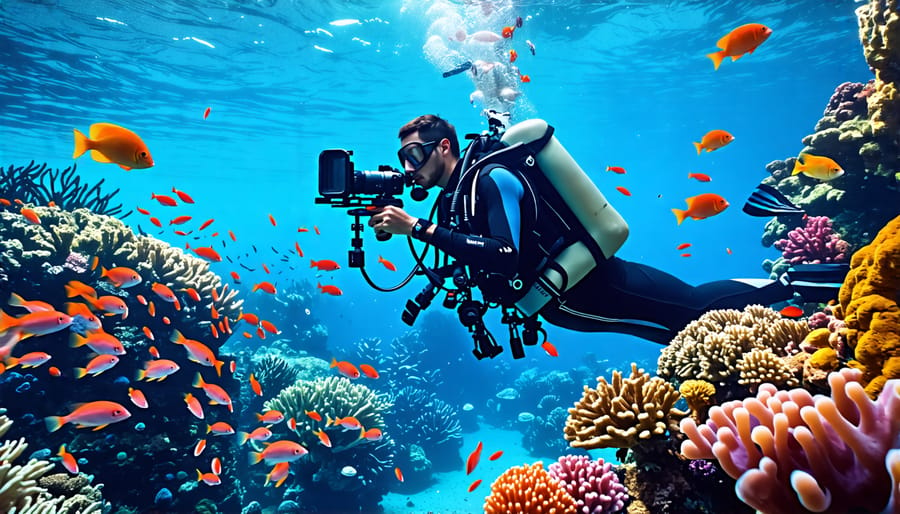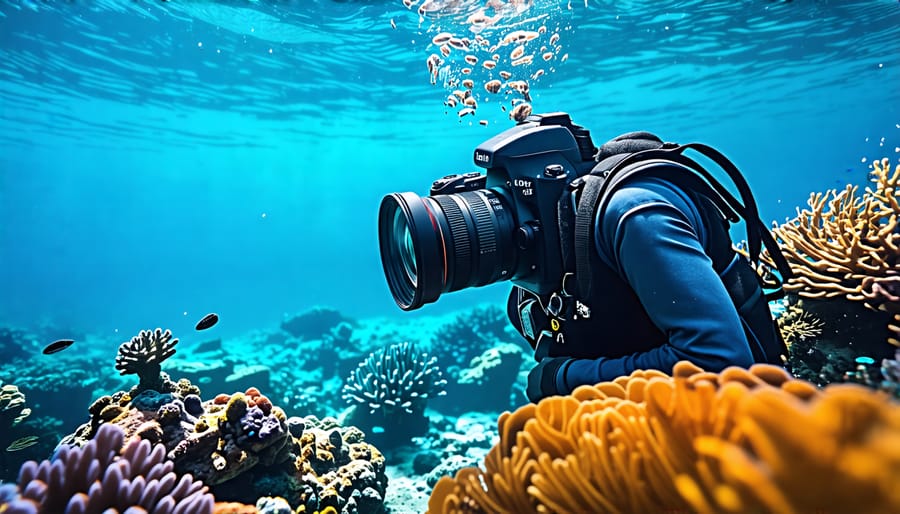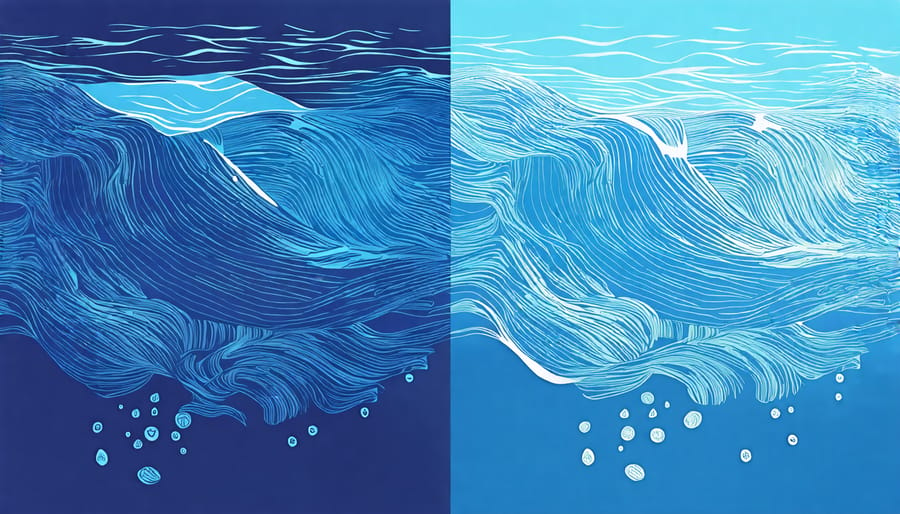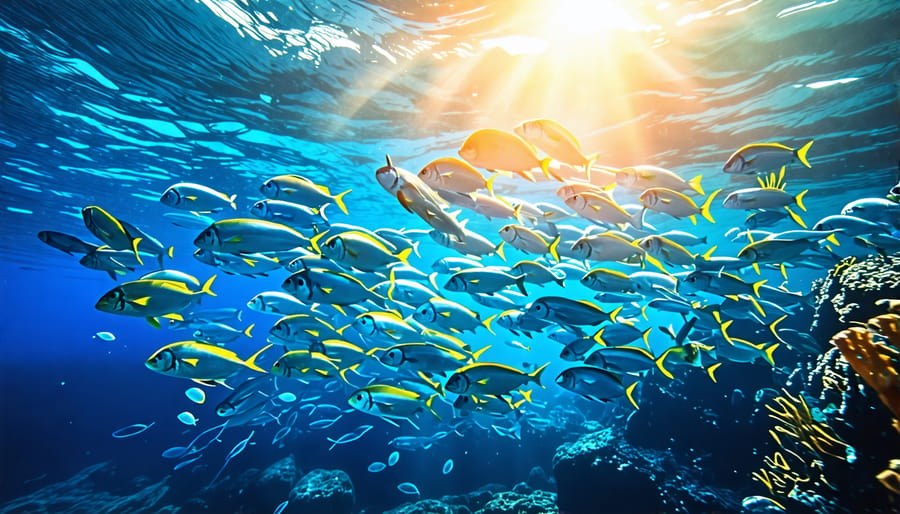
Invest in a quality waterproof housing for your camera to protect it from water pressure and prevent any accidents during your dive. Master buoyancy control by practicing regular underwater photography dives, which will allow you to hover mid-water and frame your shots perfectly without disturbing marine life. Optimize your white balance settings for accurate color reproduction, considering the unique light absorption characteristics of water, which often filters out red tones. Focus on composition by getting closer to your subject to minimize distortion and reduce the amount of water between your lens and the object, ensuring clarity and vividness in your images.
Essential Gear for Underwater Photography

Cameras and Lenses
When it comes to underwater photography, selecting the right equipment is crucial for capturing stunning images beneath the waves. Choosing a camera that’s both versatile and water-proof is the starting point. Many photographers opt for compact cameras with dedicated underwater housings, as these are generally more manageable and easier to travel with. Others might choose DSLR and mirrorless models for their outstanding image quality and lens flexibility, albeit at a higher price point and size.
Lens selection is equally important. Wide-angle lenses are popular for underwater photography because they allow photographers to get closer to subjects while still capturing expansive backgrounds, perfect for shots of coral reefs or large marine life. Macro lenses, on the other hand, are ideal for photographing smaller subjects like colorful nudibranchs or intricate reef patterns. Seasoned photographers often recommend using a combination of both, depending on your dive goals.
Investing in quality underwater housings, which not only protect your camera but also provide access to controls, is key. Whether you’re a beginner looking to improve your skills or a professional seeking to perfect your shots, start by exploring the best gear for your needs. Check out a detailed guide on Choosing a camera that suits your underwater adventures.
Underwater Housing
When embarking on the exciting journey of underwater photography, one crucial piece of equipment you’ll need is underwater housing for your camera. It serves as a protective shield, keeping your camera safe from water, pressure, and corrosion in marine environments, allowing you to capture breathtaking underwater scenes without worry. The right housing ensures not just safety, but access to necessary camera functions, enhancing your creative control underwater.
Choosing the right underwater housing depends on several factors. First, consider compatibility with your camera model to ensure a perfect fit. Then, look into the housing’s depth rating; different housings offer varying levels of water pressure tolerance based on the depth you’ll be diving. Materials matter too—acrylic housings are lighter and more affordable, while aluminum options offer more durability.
Another critical aspect is ease of use; look for housings that allow seamless operation of your camera’s controls. Practical features such as ergonomic handles or moisture alarms can significantly enhance your underwater shooting experience. Researching and investing in quality underwater housing is key to unlocking creative possibilities beneath the waves.
Lighting Equipment
Lighting is a critical component of underwater photography, transforming murky depths into vibrant scenes. Without adequate lighting, underwater images can lose their vividness, appearing dull and colorless. Natural light diminishes rapidly as you dive deeper, absorbing reds and oranges first, turning your photos a shade of blue-green. To combat this, many photographers turn to artificial lighting equipment like strobes and video lights.
Strobes, the powerful flashes that synchronize with your camera, are ideal for capturing fast-moving marine life. They restore the colors lost underwater, making your subjects pop against the aquatic backdrop. Consider positioning them at a 45-degree angle to minimize backscatter, those pesky particles that can cloud your image.
For steadier scenes like wide-angle reef shots, continuous video lights offer a constant output. They help photographers gauge exposure during composition, giving you the flexibility to adjust as needed. Always remember to balance light intensity with the ambient conditions to achieve the most natural effect. Dive in equipped with these lighting options to illuminate the hidden wonders of the underwater world.
Getting the Best Shot: Techniques and Tips
Handling Light and Color
Harnessing the nuances of light and color underwater can transform your images from flat to vibrant masterpieces. The underwater world is astonishingly colorful, but as you dive deeper, colors fade, starting with red, then orange, and so on, due to light absorption by water. This knowledge is key to managing your camera settings and white balance effectively.
To capture these hidden hues, consider using artificial lighting, such as strobes or underwater flash units, to restore colors washed out by the depths. Balancing natural light with artificial sources helps create images that accurately reflect the vivid underwater environments you’ve experienced. It’s essential to get close to your subject to minimize the amount of water between your lens and the scene, ensuring clearer shots and more accurate colors.
Remember, sunlight’s angle plays a significant role too. Early morning or late afternoon provides a softer, more diffused light that can reduce harsh shadows, producing more pleasing images. Experimenting with different times and angles can greatly impact your results. For further insights on optimizing your images, explore our resource on Mastering light, which offers tips across various photography disciplines. Through practice and experimentation, you’ll develop a keen understanding of how to leverage light and color to capture breathtaking underwater moments.
Focus and Composition
Underwater photography presents unique challenges and exciting opportunities to capture stunning images. Achieving sharp focus can be tricky due to the refraction of light making subjects appear 25% larger and closer. To ensure crystal-clear focus, approach your subject slowly and practice a steady hand technique to hold your camera. Use a fast shutter speed to counteract the motion of the water and stabilize your shot. Auto-focus can sometimes struggle in low light underwater environments, so consider using a focus light to illuminate your subject and assist your camera in locking focus.
When it comes to composition, underwater scenes offer a mesmerizing playground. Utilize the rule of thirds by positioning the subject slightly off-center to create a more engaging image. Lead your viewer’s eye by including elements like natural lines found in coral reefs or the subtle curves of a fish’s body. Get close to your subject to minimize the water column between you and them, which can often introduce haze in your image. Always be mindful of your surroundings: using elements like sunrays filtering through the water or the gentle dance of seaweed can add dynamic intrigue to your shots. Remember, practice and patience are your best allies in the deep blue, turning challenges into creative opportunities with each dive.
Overcoming Common Challenges
Underwater photography presents unique challenges, but with a little preparation and know-how, these can be easily overcome. One common issue is maintaining buoyancy while holding your camera. It’s essential to have a firm grasp on buoyancy control to prevent disturbing marine life or capturing blurry images. Consider investing in a lightweight, compact camera setup that keeps you agile, allowing you to focus on composition rather than your equipment’s weight.
Another challenge is dealing with the distortion and color loss underwater. Colors like red and orange tend to disappear as you dive deeper, leaving a blue hue. To counter this, use a red filter or adjust your white balance settings. Some photographers prefer the post-processing route, editing images to bring back the natural colors. Practice adjusting these settings during various dives until you find what best suits your shooting style.
Low light is another hurdle, especially as you go deeper. Using an external strobe or powerful dive torch can help illuminate your subjects, bringing out their vibrant colors and sharp details. Finally, patience is key. Ocean currents and moving subjects can interfere with your shot, but keeping a steady hand and calm attitude will guarantee you capture the magical moments beneath the waves. Remember, perseverance pays off in this dynamic environment.
Post-Processing for Underwater Photography

Editing Software for Beginners
When you’re new to editing underwater photographs, selecting the right software can be a game-changer. Consider starting with Adobe Lightroom, known for its user-friendly interface and comprehensive toolset that allows you to tweak colors, contrast, and exposure to bring out the natural beauty beneath the waves. For example, if you’ve captured a stunning reef scene that’s too blue, Lightroom can help balance the colors and highlight the coral’s vibrant hues.
Another great option is GIMP, especially if you’re looking for a powerful yet free solution. GIMP offers advanced features like layer editing and retouching, which can be beneficial for removing backscatter—a common underwater photography challenge caused by particles in the water.
If you’re feeling adventurous, give Luminar a try. It offers AI-driven tools to help enhance your images with minimal manual adjustments, which is perfect when you’re just getting started.
Whichever software you choose, the key is to experiment and practice. Over time, you’ll develop your workflow and discover the edits that best reflect your underwater adventures.
Advanced Editing Techniques
When it comes to refining your underwater photography, mastering advanced editing techniques can be a game-changer. These techniques not only help in bring out the vivid colors and intricate details of your underwater shots but also elevate their overall impact.
First, consider using RAW images. Shooting in RAW format, rather than JPEG, gives you more control during the editing process, allowing you to adjust exposure, color balance, and other elements with greater precision. If your photos appear washed out or too blue—as often happens underwater—using software adjustments to fine-tune your white balance can restore the natural colors of coral reefs and marine life.
Another essential technique is understanding and applying the principles of dodge and burn. By selectively brightening (dodging) or darkening (burning) areas of your image, you can enhance the depth and dimension of your underwater scenes. This can be particularly useful to highlight features of elusive creatures camouflaged amidst their environments.
Focus stacking can also be a transformative method, especially for macro photography. This involves taking several shots at different focus distances and then blending them to create an image with a greater field of depth. The result is a sharp, captivating exploration of the details that often slip by unnoticed in a single shot.
Lastly, consider experimenting with creative cropping. By carefully composing the final image, you can guide the viewer’s eye toward your intended focal point, whether it’s a flamboyant fish or the fascinating patterns of a sea fan. These editing strategies will ensure your underwater photos are as stunning as the underwater world itself, capturing more than just a memory but an evocative, awe-inspiring vision.

Inspiring Underwater Photo Projects
Underwater photography offers a mesmerizing glimpse into a world that’s both beautiful and mysterious. With the right approach, anyone can capture stunning images beneath the waves. Let’s dive into a few inspiring projects that have left an indelible mark on the genre.
One project that stands out is the work of Elena Kalis, who melds art and storytelling beneath the surface. Through her series inspired by ‘Alice in Wonderland,’ Elena creates dreamlike scenes that transport viewers into a fairytale realm, showcasing her ability to blend imagination with the underwater environment. This project isn’t just about technical prowess but also about weaving narrative into each frame, inspiring photographers to think beyond conventional limits.
Then there’s the ‘Sea Legacy’ initiative, co-founded by Paul Nicklen and Cristina Mittermeier, which focuses on conservation efforts. Through their compelling underwater photography, they highlight the fragile beauty of marine ecosystems, urging global audiences to take notice and action. By leveraging powerful visuals, ‘Sea Legacy’ demonstrates the impact of storytelling and the critical role photography plays in conservation.
For those eager to improve their Photography skills, these projects emphasize the importance of creativity and purpose in underwater photography. Whether you’re exploring compositions or experimenting with light, drawing inspiration from these pioneers can revolutionize the way you view the oceans and your role as a storyteller.
Conclusion: Taking the Plunge
Taking the plunge into underwater photography is an exciting venture, full of creative opportunities and challenges. Equipped with newfound knowledge and practical tips, you’re ready to capture the captivating world beneath the waves. Remember, practice makes perfect, so don’t hesitate to experiment with different techniques and settings. Whether you’re an enthusiast looking to capture the beauty of marine life or a professional aiming to expand your portfolio, the depths offer a unique canvas for your art. Embrace the adventure, stay curious, and let your passion for photography guide you into this mesmerizing realm. Happy shooting!






















